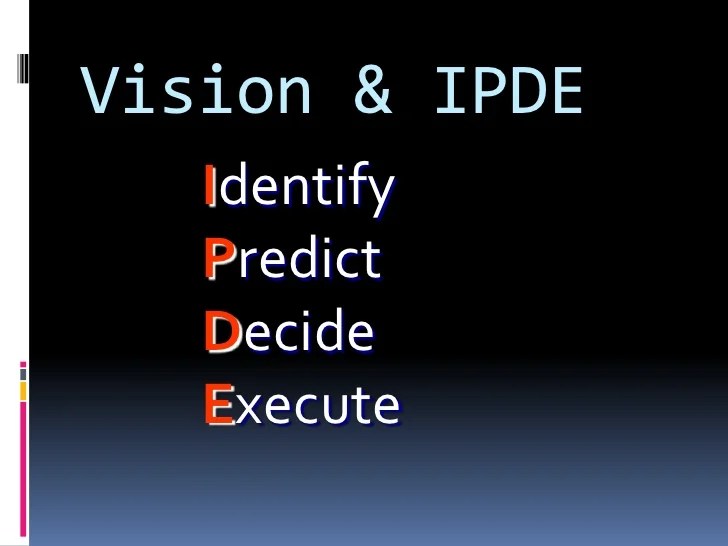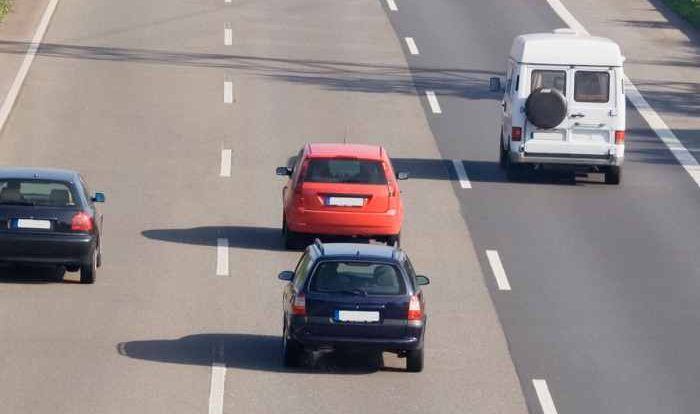What does ipde stand for in driving – In the realm of driving, safety reigns supreme. Understanding and applying the IPDE process, an acronym that stands for Identify, Predict, Decide, and Execute, is paramount to ensuring a safe and responsible driving experience. This comprehensive guide delves into the intricacies of IPDE, empowering drivers with the knowledge and skills to navigate the complexities of the road.
The IPDE process serves as a systematic framework that guides drivers through a series of cognitive steps, enabling them to anticipate and respond effectively to potential hazards. By embracing IPDE, drivers can enhance their situational awareness, reduce reaction times, and make informed decisions behind the wheel.
IPDE Acronym

IPDE is an acronym commonly used in driver education and training to describe a four-step process for safe and effective driving. It stands for:
Identify – Predict – Decide – Execute
| Acronym | Meaning |
|---|---|
| Identify | Scanning the environment and recognizing potential hazards. |
| Predict | Anticipating the actions of other drivers and potential hazards based on the identified information. |
| Decide | Making appropriate decisions based on the predictions and selecting the best course of action. |
| Execute | Carrying out the decided action smoothly and safely. |
IPDE Components

The IPDE process is a systematic approach to driving that helps drivers identify potential hazards, predict their actions, decide on the best course of action, and execute that action safely. Each component of IPDE plays a crucial role in safe driving practices.
Identify
Identifying potential hazards is the first step in the IPDE process. This involves scanning the road ahead and being aware of your surroundings. Potential hazards can include other vehicles, pedestrians, cyclists, animals, road conditions, and weather conditions. By identifying potential hazards early, you can start to plan your response.
For example, if you see a pedestrian crossing the street ahead, you can start to slow down and prepare to stop. Or, if you see a car coming towards you in the opposite lane, you can start to adjust your speed and position to avoid a collision.
Predict
Once you have identified potential hazards, the next step is to predict their actions. This involves thinking ahead and anticipating what other drivers, pedestrians, and cyclists might do. By predicting their actions, you can start to plan your own response.
For example, if you see a car coming towards you in the opposite lane and they are not slowing down, you can predict that they may not see you and could potentially collide with you. This will help you to make a decision about what to do, such as slowing down or moving to the side of the road.
Decide
Once you have predicted the actions of potential hazards, the next step is to decide on the best course of action. This involves considering all of your options and choosing the one that is safest. Your decision will be based on a number of factors, including the speed and position of other vehicles, the road conditions, and the weather conditions.
For example, if you are approaching a busy intersection and you see a car coming towards you from the left, you may decide to slow down and wait for them to pass. Or, if you are driving on a slippery road, you may decide to reduce your speed and increase your following distance.
Execute
The final step in the IPDE process is to execute your decision. This involves taking the necessary actions to avoid a collision. Your execution will be based on the decision you made in the previous step.
For example, if you decided to slow down and wait for a car to pass at an intersection, you would need to apply the brakes and slow down your vehicle. Or, if you decided to reduce your speed and increase your following distance on a slippery road, you would need to adjust your speed and maintain a greater distance from the vehicle in front of you.
Benefits of IPDE

Implementing the IPDE process while driving offers several advantages that enhance road safety and improve overall driving performance.
One significant benefit of IPDE is its ability to heighten situational awareness. By constantly scanning the environment, identifying potential hazards, and predicting their possible actions, drivers can anticipate and prepare for potential risks more effectively. This heightened awareness allows drivers to make informed decisions and respond appropriately to changing road conditions, reducing the likelihood of accidents.
Enhanced Reaction Time
IPDE also contributes to reducing reaction time in critical situations. By continuously assessing the driving environment, drivers using IPDE can identify potential hazards earlier and have more time to react appropriately. This increased reaction time can be crucial in preventing accidents or mitigating their severity.
Research Findings
Numerous studies have demonstrated the positive impact of IPDE on driving safety. A study conducted by the National Highway Traffic Safety Administration (NHTSA) found that drivers who used the IPDE process experienced a 30% reduction in crashes and a 25% reduction in traffic violations.
IPDE in Different Driving Situations

IPDE is a flexible and adaptable framework that can be applied effectively in various driving conditions, each presenting unique challenges and requiring tailored adjustments to ensure safe and efficient navigation.
When driving in urban traffic, the emphasis of IPDE shifts towards increased anticipation and hazard recognition. The dense and unpredictable nature of city streets demands heightened awareness of potential conflicts, such as pedestrians, cyclists, and other vehicles. Drivers must continuously scan their surroundings, identify potential threats, and adjust their driving behavior accordingly.
Highway Driving, What does ipde stand for in driving
On highways, IPDE focuses on maintaining a safe following distance, managing speed effectively, and anticipating potential hazards. The higher speeds and longer distances involved require drivers to make decisions with greater lead time. By constantly monitoring traffic flow, adjusting speed to maintain a safe buffer, and being aware of potential hazards, drivers can minimize the risk of collisions and ensure a smooth and efficient journey.
Adverse Weather Conditions
In adverse weather conditions, IPDE plays a critical role in maintaining vehicle control and minimizing the risk of accidents. Drivers must adapt their driving behavior to account for reduced visibility, slippery road surfaces, and potential hazards such as hydroplaning or black ice.
By reducing speed, increasing following distance, and being extra cautious when approaching intersections or curves, drivers can enhance their safety and navigate challenging weather conditions more effectively.
IPDE Training and Education: What Does Ipde Stand For In Driving

Incorporating IPDE training into driver education programs is crucial for equipping novice drivers with the necessary skills to navigate diverse driving environments safely and efficiently. IPDE training provides a systematic framework for drivers to perceive, process, and respond to potential hazards on the road, reducing the risk of accidents.
Best Practices for Teaching IPDE Skills
Effective IPDE training involves a combination of classroom instruction, practical exercises, and simulation-based scenarios. Classroom instruction should focus on explaining the IPDE acronym and its components, emphasizing the importance of each step in the decision-making process. Practical exercises allow learners to apply IPDE principles in real-world driving situations under controlled conditions.
Simulation-based scenarios provide a safe and immersive environment for learners to practice IPDE skills and develop their hazard perception and response capabilities.
Assessing IPDE Skills
Assessing IPDE skills is essential to evaluate learner progress and identify areas for improvement. Assessment can be conducted through a combination of written tests, driving observations, and simulated driving scenarios. Written tests can assess learners’ understanding of IPDE concepts, while driving observations allow instructors to evaluate learners’ application of IPDE skills in real-world driving situations.
Simulated driving scenarios provide a controlled environment to assess learners’ ability to identify and respond to hazards in a timely and appropriate manner.
Effective Training Materials
Numerous resources and training materials are available to support IPDE training. The National Highway Traffic Safety Administration (NHTSA) offers a comprehensive IPDE training curriculum, including lesson plans, student materials, and instructor guides. Other organizations, such as the American Automobile Association (AAA) and the National Safety Council (NSC), also provide IPDE training materials and resources.
Popular Questions
What is the significance of identifying hazards in the IPDE process?
Identifying hazards is the foundation of the IPDE process. It involves scanning the environment, recognizing potential threats, and assessing their severity. This step enables drivers to anticipate and prepare for potential dangers, reducing the likelihood of accidents.
How does predicting outcomes contribute to safe driving?
Predicting outcomes involves anticipating the consequences of potential actions. By considering the possible outcomes of their decisions, drivers can make informed choices that minimize risks and enhance safety.
Why is making timely decisions crucial in the IPDE process?
Making timely decisions is essential for effective hazard management. Once hazards are identified and predicted, drivers need to make quick and decisive choices to avoid or mitigate risks. Delaying decisions can increase the likelihood of accidents.
How does executing maneuvers safely ensure driver and passenger safety?
Executing maneuvers safely involves carrying out decisions in a controlled and precise manner. This includes maintaining appropriate speed, following safe distances, and performing maneuvers smoothly. Proper execution of maneuvers minimizes the risk of collisions and ensures the well-being of occupants.

